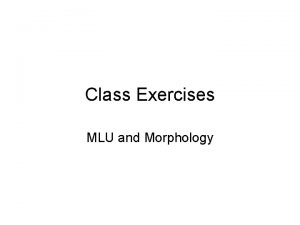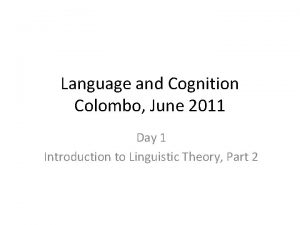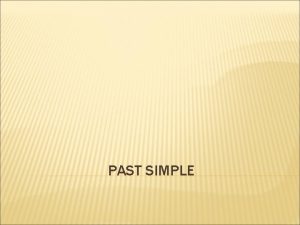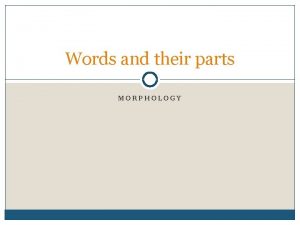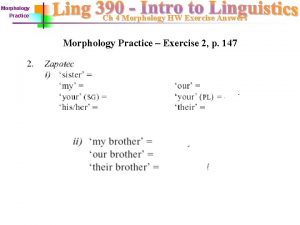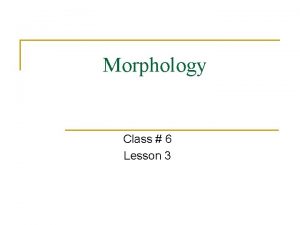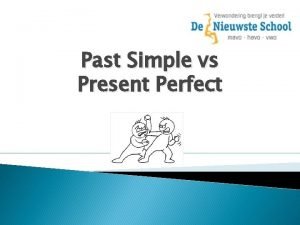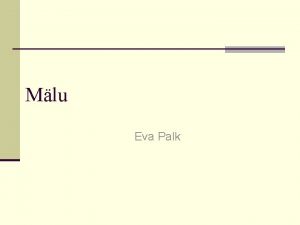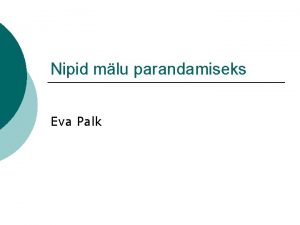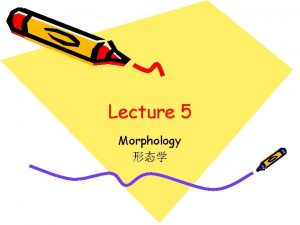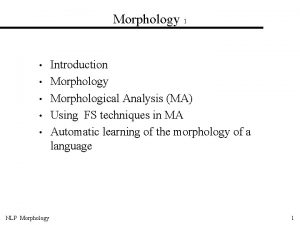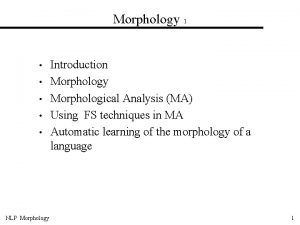Class Exercises MLU and Morphology ed past ex












- Slides: 12

Class Exercises MLU and Morphology

• • • • ed (past) ex (out of, from) mis (negative, wrong) out (extra , beyond) over (too much) post(behind) al (pertaining) en (used to form verbs from adjectives) ism (doctrine, state) ist (one who does something) ity (used for abstract nouns) lv (used to form adverbs) ing (at present) ‘s (possession) • • • • bi (twice) semi (half) super (superior) trans (across) tri (three) un (not) under de (reversal) pre (before) pro (in favor of) re (again) able (ability) ize (action, policy) less (without) ly( used to form adverb) s (plural) • ness (quality) • er, or (used as agentive ending) • ous ( full) • y (inclined to) • ance ( action, state) • est (superlative) • ful (full, tending) • ible (likelihood) • ish (belonging to) • s (third person marker)

Prefixes Derivation Suffixes al Inflectional


Calculating MLU Do’s and don’ts • • • Exclude from your count Imitations Elliptical answers Partial utterances Unintelligible utterances Rote passages False starts and Reformulations within utterances Noises Discourse markers Identical utterances Counting or other sequences of enumeration Single words or phrases Count as one morpheme • • • Uninflected lexical morphemes Contractions Concatenatives Inseparable linguistic units Irregular past tense Plurals which do not occur in singular form • Gerunds and participles that are not part of the verb phrase • Inflectional forms • Contractions • You need at least 50 utterances to calculate MLU • 100 is recommended Lund and Dunchan (1993)

Calculating MLU • After you have counted all the morphemes, you are ready to calculate the MLU. The traditional method of calculating MLU is dividing the number of morphemes by the number of utterances. For example: 150 morphemes / 50 utterances = 3. 0 MLU

Sample 1 1) Calculate MLU 2) which of Brown’s developmental stages has the child reached? 3) identify the morphemes used by the child 4) identify the semantic functions used by the child

• • • • • • • *CHI: why dis got holes? %act: looking at holes in Ursula's pad *URS: so you can put it in a notebook # if you like. *CHI: 0. %act: falls from bike *URS: what happened? *CHI: I fall # broke my head. *URS: you didn't. *CHI: tell me story. *URS: shall we look at these first? %act: gives Adam bag of toys *CHI: let's open it. *CHI: what is it? *URS: it's a watch. *CHI: dat's a watch. *CHI: fourteen clock. *URS: what is it? *CHI: fourteen o'clock. *CHI: stop it. *URS: what? *CHI: stop it. *CHI: turn back on. *CHI: has wings. *URS: where? • • • • • • • *CHI: turn it. *CHI: stop it. *CHI: it's fourteen clock. *CHI: enough clock. *CHI: in go clock. %act: putting watch away *CHI: a tape recorder. *CHI: where is a box? %act: <aft> taking watch out again *CHI: it's fourteen clock. *CHI: it not fourteen clock # it nineteen # six # how d(o) you know? *CHI: it's not six # it number two. *CHI: how d(o) you know it going eat supper? %exp: presumably the watch *CHI: how (a)bout eat supper? *CHI: it's fourteen o'clock. *CHI: well # well. *CHI: it's fourteen cl(ock) # clock. *CHI: achoo@o. *CHI: le(t) me stop it. *CHI: le(t) me turn on. *CHI: xxx put in. *CHI: put in. %act: puts watch back in box *CHI: it's go to sleep.

Stage I II IV V Age ( years) 1 -2: 2 2: 3 -2: 6 2: 7 -2: 10 2: 11 -3: 4 3: 5 -3: 10 MLU 1: 0 -2: 0 -2: 5 -3: 0 -3. 75 3: 75 -4: 5

Semantic Roles

Two-word utterances • Possessives – daddy coffee – Andrew shoe • Property-indicators – – – big balloon little shell all wet ball wet pants dirty face old cookie • Recurrence / number / disappearance – – more glass two plane all gone bee window bye-bye • Locatives – ball daddy (TO) – stick car (IN) • Actor/Action – mommy sit – daddy work – Andrew sleep • Others – eat dessert – bounce ball

Semantic Relations in 1 -word stage • POSSESSION • IMPERATIVE • NEGATIVE • LOCATION • RECURRENCE • DISAPPEARANCE “Daddy” (=slippers) “open” = open the jar “blow” = blow my nose “no” = negate actions “down” = getting down from high chair “more” “allgone”
 Past progressive affirmative
Past progressive affirmative Past simple past perfect past continuous exercises
Past simple past perfect past continuous exercises What is inflectional and derivational morphology
What is inflectional and derivational morphology Calculating mlu
Calculating mlu Jordan mlu
Jordan mlu How to calculate mlu
How to calculate mlu Past simple negative form
Past simple negative form Inflectional and derivational morphemes exercises
Inflectional and derivational morphemes exercises Morphology practice
Morphology practice Nunbelievable menu
Nunbelievable menu Present past future simple exercises
Present past future simple exercises Past simple vs present perfect
Past simple vs present perfect Cuando usamos el past continuous
Cuando usamos el past continuous



